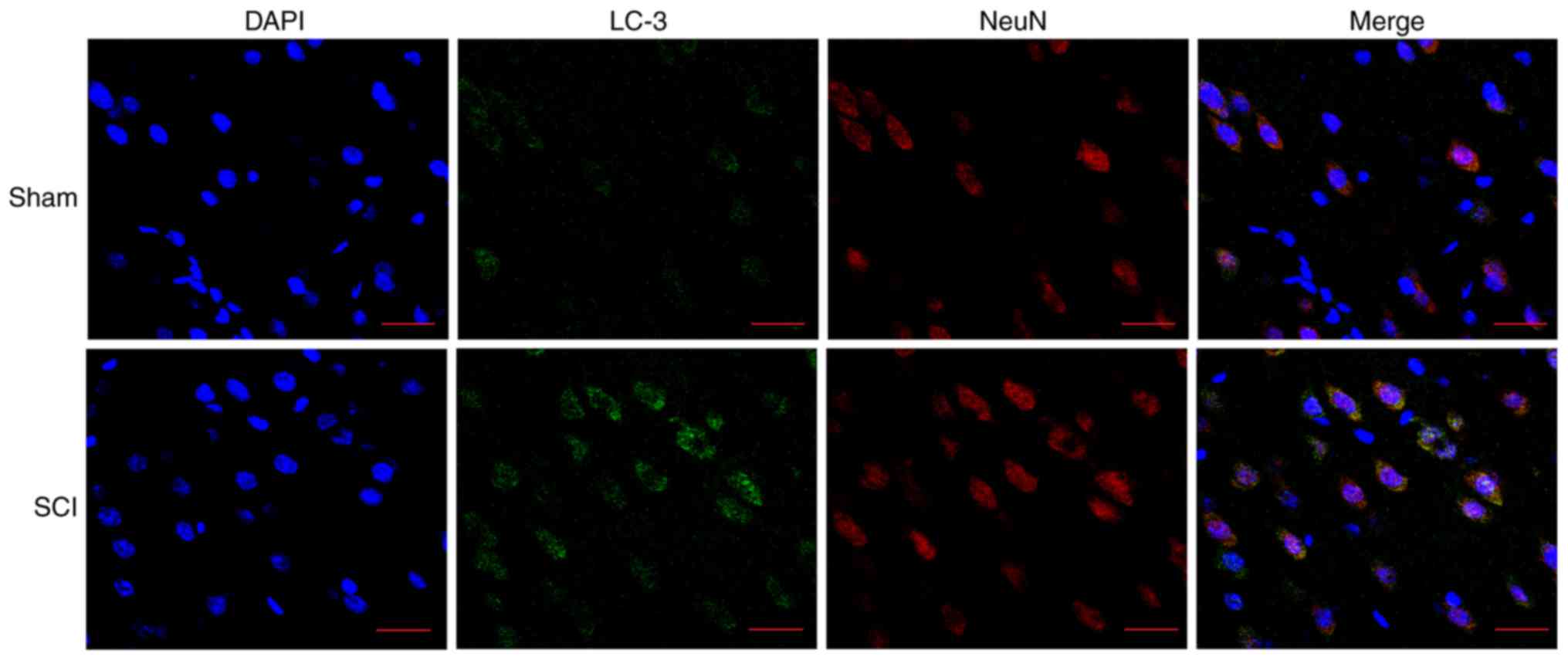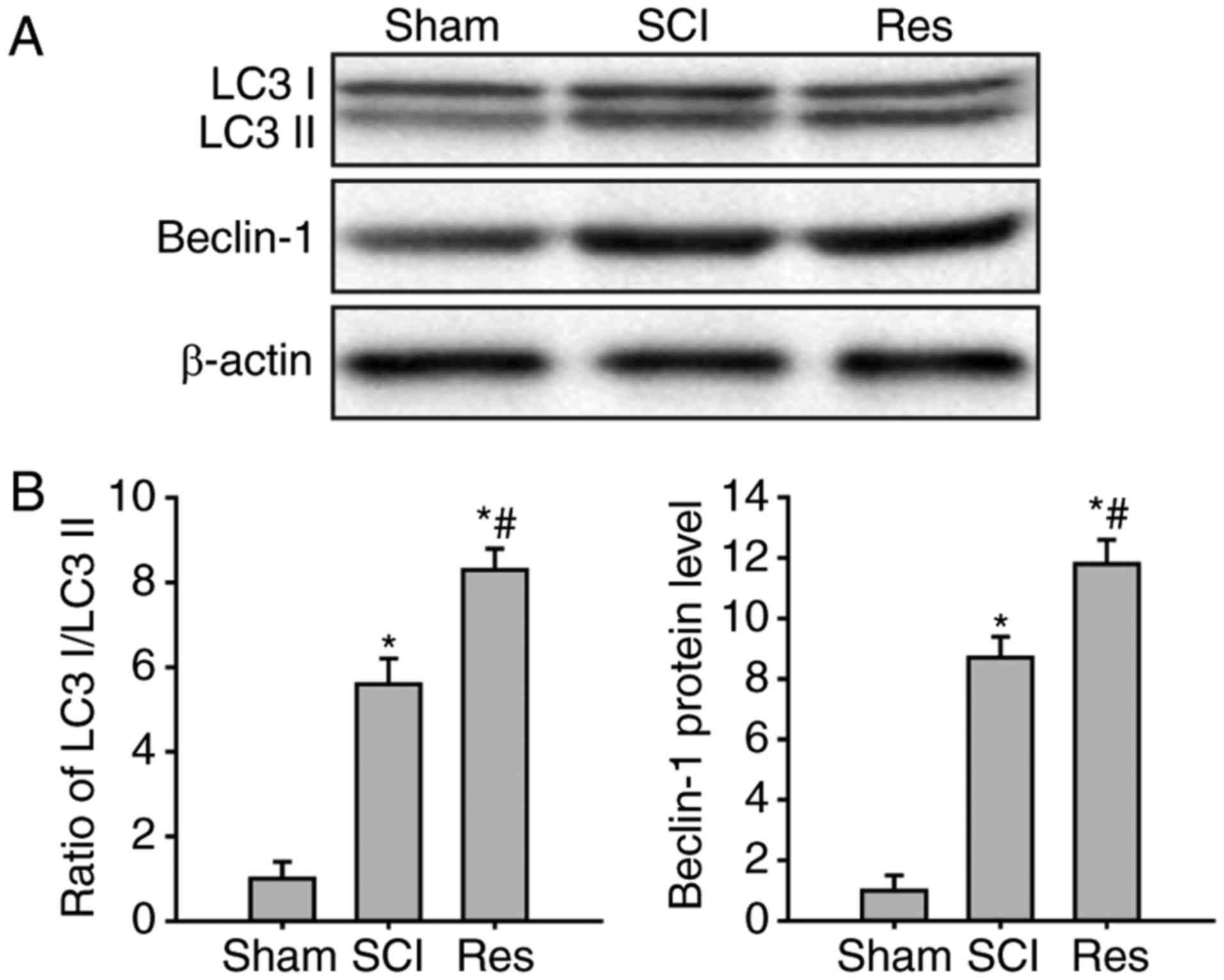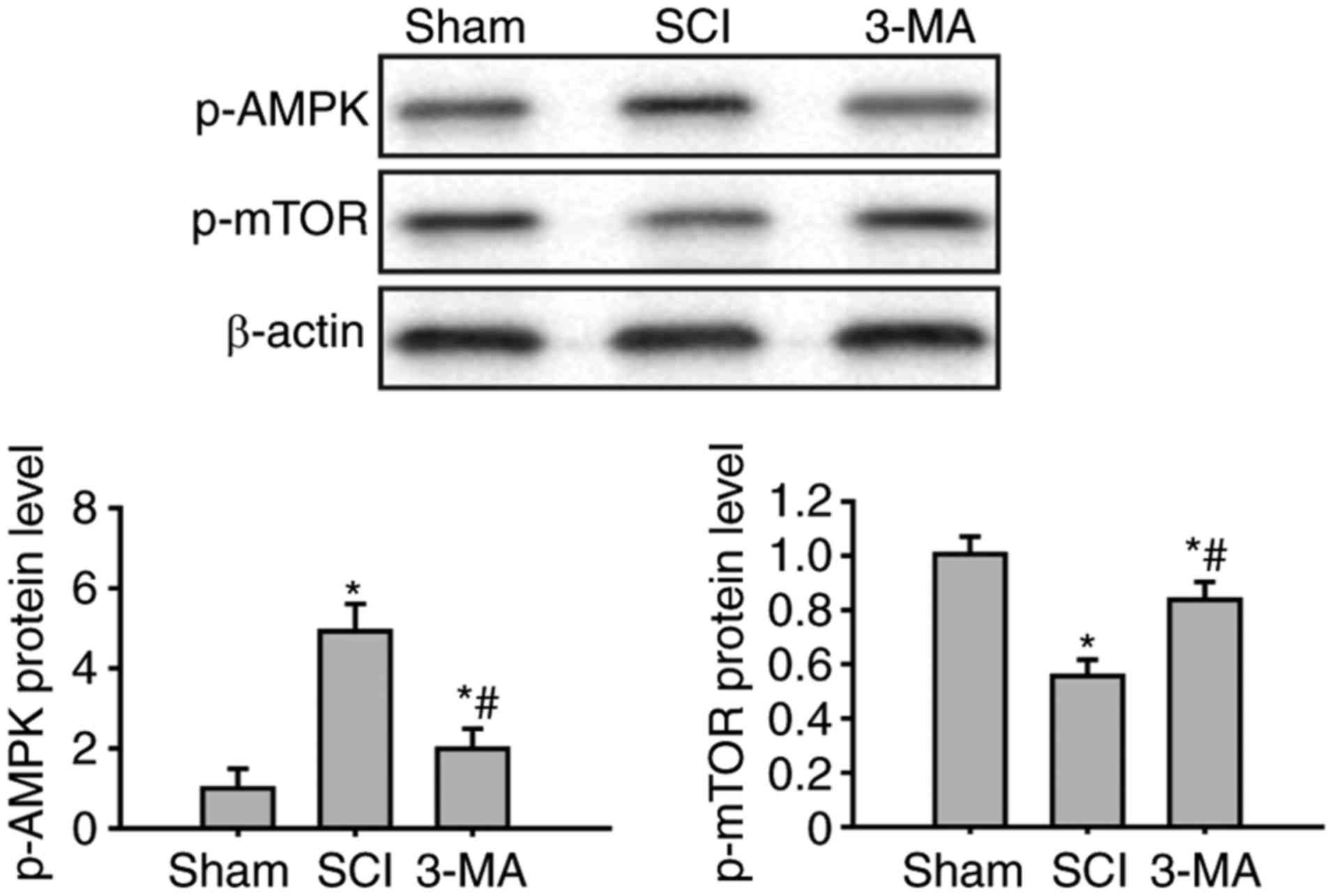Introduction
Spinal cord injury (SCI) is one of the most
important causes of mortality and long-term disability among young
adults worldwide. In the United States alone, ~273,000 affected
individuals and >12,000 new cases are reported annually
(1). The pathophysiology of SCI
comprises primary injury and the secondary injury; the primary
injury is attributed to mechanical forces applied to the spinal
cord, whereas the secondary injury is a complex cascade of
cellular, molecular and biochemical events, including inflammation,
axonal disruption, electrolyte disorders, oxidative stress,
apoptosis and autophagy, which are important in the physical and
functional deficits following SCI (2,3).
These secondary effects can result in the loss of motor neurons and
permanent neurological deficits, leading to a wide range of
disabilities, which significantly impact on quality of life
(4). Although the defined
molecular mechanism of this secondary injury remains controversial,
the reduction of secondary injury is generally recognized as an
effective treatment for SCI.
Autophagy is a highly conserved catabolic mechanism
for the degradation of cytoplasmic constituents in the
autophagosomal-lysosomal pathway, which can promote cell survival
and induce cell death depending on the specific pathological events
(5). It is reported that autophagy
may rescue neuronal cell death in certain neurodegenerative
diseases (6). Evidence has
demonstrated that autophagy is essential in maintaining cellular
homoeostasis and protecting against a variety of diseases in the
central nervous system (CNS) (7,8). As
demonstrated in previous studies, activated autophagy has been
implicated in animal models of traumatic SCI (7,9,10);
however, its neuroprotective or neurodegenerative effect remains
controversial. Whether the function of autophagy induced by SCI is
protective or detrimental remains to be elucidated.
Resveratrol (3,4′,5-trihydroxystilbene), a
plant-derived polyphenolic compound found in red grapes, peanuts
and mulberries (11), has a wide
variety of beneficial effects on health, including antitumor,
anti-inflammatory, anti-oxidation and neuroprotective activities
(12). Previous studies have also
indicated that resveratrol has neuroprotective properties in
various types of acute CNS injuries, including stroke, subarachnoid
hemorrhage, traumatic brain injury and SCI (13). It has been demonstrated that
resveratrol promotes neurobehavioral and histopathological recovery
following experimental SCI in rats (14). In addition, resveratrol treatment
alleviates the SCI-induced systemic inflammatory response via
suppressing the activity of nuclear factor (NF)-κB and upregulating
the expression of sirtuin 1 (SIRT1) (15). However, whether autophagy is
associated with the neuroprotective effect of resveratrol treatment
following SCI has not been reported. The present study investigated
the neuroprotective effects of resveratrol on SCI and the potential
molecular mechanisms.
Materials and methods
Animals
A total of 120 adult male Sprague-Dawley rats
(250–300 g, 8–12 weeks) were purchased from Beijing Vital River
Laboratory Animal Technology Co., Ltd. (Beijing, China). All rats
were housed in standard temperature conditions (23±25°C) with a
12-h light/dark cycle, and free access to food and water. All
experimental procedures and protocols were approved by the Animal
Care and Use Committee of Hebei Medical University (Shijiazhuang,
China). All efforts were made to minimize the number of animals
used in the experiments and their suffering; there were five rats
were in every group at each observation time point in each
experiment.
Acute SCI model
The SCI model was established based on Allen's
method (16). In brief, the
experimental rats were anesthetized via an intraperitoneal
injection of sodium pentobarbital (65 mg/kg). Following
sterilization with 75% alcohol, a cut was made in the skin and
muscles were separated to expose the lamina. The T9/10 spinous
process was exposed and clamped with rongeur forceps. The vertebral
plates were removed to expose the spinal cord. An impactor (2.0 mm
in diameter; 10 g) was vertically dropped from a 25.0 mm height,
which directly impacted the spinal cord at T9/10. Hematoma occurred
at the injury site, with rapid contraction and tremor of hind
limbs, which confirmed successful establishment of the model. The
rats in the sham group received the same surgical procedures, but
without impaction applied to the spinal cord.
Drug administration
Resveratrol and 3-methyladenine (3-MA) from
Sigma-Aldrich; Merck KGaA (Darmstadt, Germany) were dissolved in
dimethyl sulfoxide and further diluted in PBS to a final dose prior
to intraperitoneal injection. The rats in the SCI + Res group were
administered with a single dose of resveratrol (100 mg/kg, i.p),
Animals in the SCI + Res + 3-MA group were injected with
resveratrol (100 mg/kg, i.p) and 3-MA (2.5 mg/kg, i.p) immediately
following injury.
Assessment of neurological function
recovery
The locomotion recovery of the rats was assessed
using the Basso, Beattie, Bresnahan (BBB) open-field locomotor
rating scale (17) on days 1, 3,
7, 14 and 21 following SCI. Briefly, the BBB scores range between 0
and 21 points. A score of 0 indicates complete paralysis, and a
score of 21 indicates normal locomotion. Each evaluation was
completed by two researchers who were blinded to the experimental
groups. The inclined plane test was also performed to evaluate
locomotion recovery, as described previously (18), at the same time.
ELISA analysis
The spinal cords were collected, homogenized and
centrifuged for 20 min at 3,000 × g, 4°C. The contents of tumor
necrosis factor (TNF)-α (cat. no. SMTA00B), IL-1β (cat. no.
SMLB00C) and interleukin (IL)-10 (cat. no. SM1000B) in the contused
spinal cord were determined using respective ELISA kits (R&D
Systems, Inc., Minneapolis, MN, USA) according to the
manufacturer's protocol, and analyzed using a microplate reader
(Dynex Technology, Chantilly, VA, USA). The absorbance was
quantified at 450 nm. The levels of TNF-α, IL-1β and IL-10 in each
sample were calculated based on the standard curve.
Immunofluorescence staining
The spinal cords were fixed in Tissue OCT-Freeze
Medium (NobleRyder Technology, Inc., Beijing, China; http://www.nobleryder.cn) at room temperature for 12 h
and cut into 10-µm sections. The sections were blocked with 10%
bovine serum albumin (Jackson ImmunoResearch Laboratories, Inc.,
West Grove, PA, USA) for 1 h at room temperature. To locate the
autophagy marker microtubule-associated protein light chain 3 (LC3)
in neurons, LC3/neuronal nuclei (NeuN)/DAPI double fluorescence
staining were performed. The sections were incubated overnight at
4°C with the following mixed primary antibodies: Mouse anti-NeuN
antibody (1:500; Abcam, Cambridge, UK; cat. no. GR51694-1) and
rabbit anti-LC3 antibody (1:500; Santa Cruz Biotechnology, Inc.,
CA, USA; cat. no. 12741). The following day, mixed secondary
antibodies (1:2,000) corresponding to the primary antibodies were
added to the sections at 37°C for 2 h, which included green donkey
anti-mouse IgG (1:2,000) and red donkey anti-rabbit IgG (1:2,000;
cat. no. 142401B; both Abbkine, Redlands, CA, USA; cat. no.
133702A). The nuclei were incubated with counterstain solution for
15 min. All images were captured on a Leica DMI4000B microscope
(Leica Microsystems GmbH, Wetzlar, Germany).
Western blot analysis
Total proteins in the spinal cord were extracted in
RIPA lysis buffer (Beyotime Institute of Biotechnology, Shanghai,
China), suspended and centrifuged at 12,000 × g, 4°C for 10 min.
The protein concentrations were determined using the Pierce BCA
method (Thermo Fisher Scientific, Inc. Waltham, MA, USA). The
protein samples (20 µg) were separated by electrophoresis on 10%
separation gels and then transferred onto a polyvinylidene
difluoride membrane (EMD Millipore, Bedford, MA, USA). Following
blocking with 5% non-fat milk for 2 h at 37°C, the membranes were
incubated overnight at 4°C with the following primary antibodies:
Rabbit anti-LC3 antibody, and rabbit anti-Beclin-1 antibody (cat.
no. 3738), rabbit anti-AMPK antibody (cat. no. 5831), rabbit
anti-p-AMPK antibody (cat. no. 2535), rabbit anti-mTOR antibody
(cat. no. 2983) rabbit anti-p-mTOR antibody (cat. no. 2971) and
rabbit anti-β-actin (cat. no. 8457) from Cell Signaling Technology,
Inc. (Danvers, MA, USA) at 1:1,000 dilutions. Following washing in
TBST, HRP-conjugated secondary antibodies (1:5,000 cat. no. 7074;
Santa Cruz Biotechnology, Inc.) were added for signal development
for 2 h at 37°C. Immunoreactivity was visualized using an ECL kit
(GE Healthcare Life Sciences, Amersham, UK) and quantitatively
analyzed using ImageJ software v 1.8.0 (NIH, Bethesda, MD, USA).
Independent experiments were performed in triplicate, and
quantities of band densities were normalized using β-actin.
Statistical analysis
All data are expressed as the mean ± standard
deviation of three independent experiments. Statistical analyses
were performed with the Prism software package (GraphPad v5;
GraphPad Software, Inc., La Jolla, CA, USA). Unpaired Student's
t-test was used for comparison of simple effects between two
groups. One-way analysis of variance followed by Dunnett's post hoc
test was used for comparisons among multiple groups. P<0.05 was
considered to indicate a statistically significant difference.
Results
Resveratrol promotes the recovery of
neurological dysfunction following SCI in vivo
To investigate the effects of resveratrol on
locomotor functional recovery following SCI, BBB scoring and an
inclined plane test were performed on days 1, 3, 7, 14 and 21
post-injury. No significant difference in motor function was
detected in any rats prior to model establishment. As shown in
Fig. 1A, there was no locomotor
dysfunction in the rats in the sham group between days 1 and 21.
The BBB locomotor scores were lower in the SCI group in comparison
to those in the sham group at 3, 7, 14 and 21 days post-SCI.
Treatment with resveratrol markedly increased the BBB scores
following SCI at 7, 14 and 21 days post-SCI. Similarly, the
inclined plane test scores were consistently lower in the SCI group
following injury, which were significantly elevated by resveratrol
treatment (Fig. 1B). These results
suggested that resveratrol improved the behavioral dysfunction
caused by SCI.
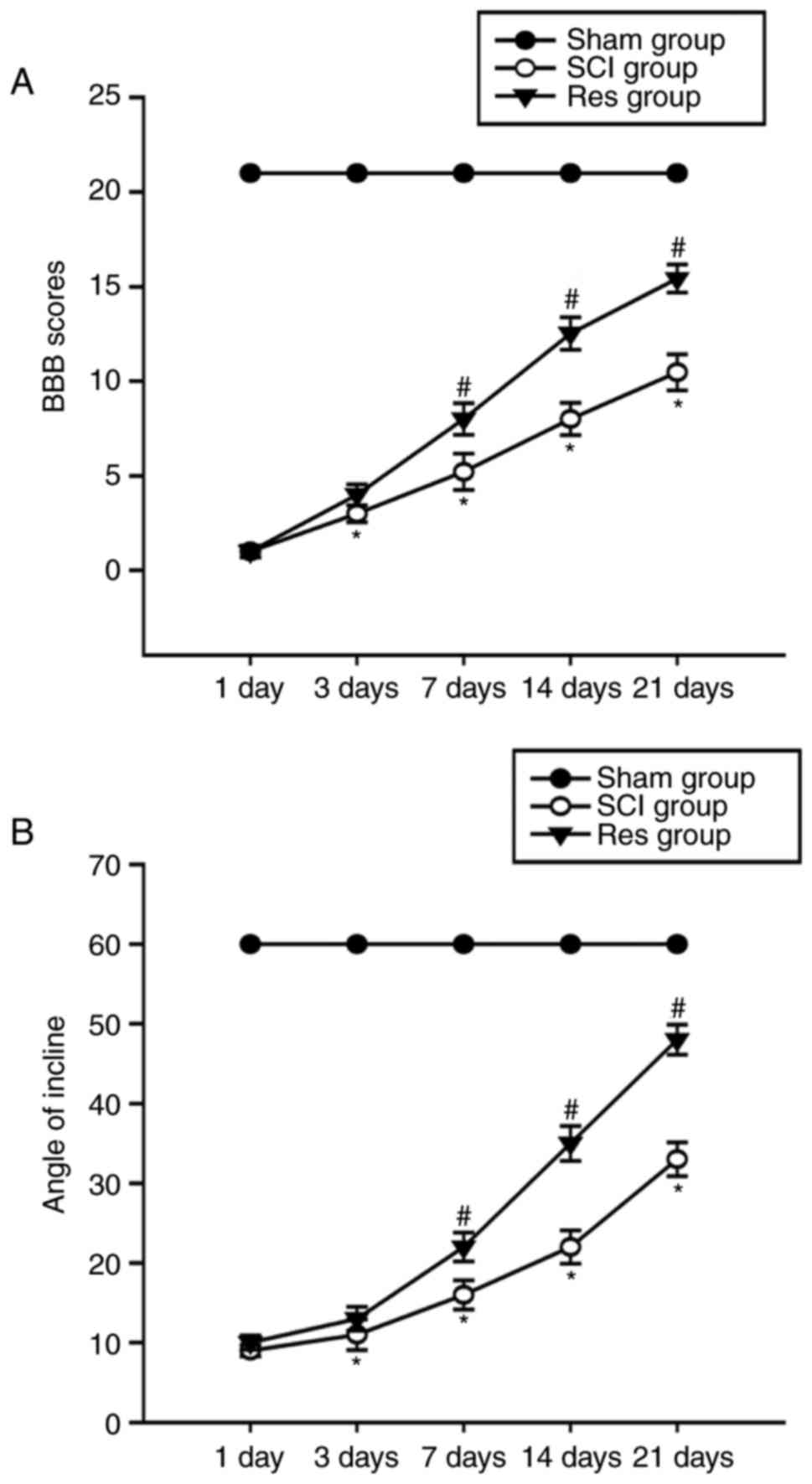 | Figure 1.Effects of resveratrol on motor
function in rats following SCI. (A) BBB scores of rats in each
group at 1, 3, 7, 14 and 21 days post-injury. (B) Inclined plane
test scores in each group at 1, 3, 7, 14 and 21 days post-injury.
Data are presented as the mean ± standard deviation. *P<0.05 vs.
sham group; #P<0.05, vs. SCI group. SCI, spinal cord
injury; Res, resveratrol; BBB, Basso, Beattie, Bresnahan. |
Resveratrol suppresses SCI-induced
neuroinflammation in rats
To determine the effect of resveratrol
administration on neuroinflammatory responses, the present study
analyzed the levels of pro-inflammatory cytokines TNF-α and IL-1β,
and anti-inflammatory cytokine IL-10 in the contused spinal cord
using ELISA. As shown in Fig. 2A and
B, the levels of TNF-α and IL-1β were significantly increased
post-SCI, whereas the level of IL-10 was significantly decreased in
the spinal cord of the SCI model (Fig.
2C), compared with that in the sham animals. The
intraperitoneal administration of resveratrol following SCI
resulted in a significant reduction in the levels of TNF-α and
IL-1β, and an upregulation in the level of IL-10 between days 3 and
21 post-injury. These data indicated that resveratrol significantly
inhibited the neuroinflammatory response at the lesion site
following SCI.
 | Figure 2.Effects of resveratrol on the
expression of inflammatory factors following SCI. The levels of
pro-inflammatory factors (A) TNF-α and (B) IL-1β, and
anti-inflammatory factor (C) IL-10 at 1, 3, 7, 14 and 21 days
following SCI were examined using ELISA analysis. Data are
presented as the mean ± standard deviation. *P<0.05, vs. sham
group; #P<0.05, vs. SCI group. SCI, spinal cord
injury; Res, resveratrol; TNF-α, tumor necrosis factor-α; IL,
interleukin. |
Resveratrol enhances SCI-mediated
neuronal autophagy
The present study also evaluated the induction of
autophagy following SCI by detecting the expression of
autophagy-associated proteins LC3 and Beclin-1, which are
considered two primary markers of autophagy. The conversion of
LC3-I to LC3-II is essential for the formation of autophagosomes.
The results of the immunofluorescence analysis suggested that LC3
was predominantly expressed in NeuN-positive neurons 3 days
following SCI (Fig. 3). Western
blot analysis demonstrated that the expression levels of Beclin-1
and the ratio of LC3-II/LC3-I were significantly increased 1 day
following injury and peaked 3 days following injury, compared with
those in the sham group (Fig. 4A and
B), which was further enhanced following resveratrol treatment
(Fig. 5A and B). Therefore, these
results suggested that autophagy was activated in the injured
spinal cord following SCI and further enhanced by resveratrol
treatment.
Resveratrol improves functional
recovery and inflammation by enhancing autophagy
To investigate the potential mechanism underlying
the neuroprotective effects of resveratrol, intraperitoneal
injections of resveratrol and 3-MA were performed following SCI
surgery. 3-MA, an inhibitor of autophagy, inhibits class III
phosphoinositide 3-kinase to suppress the formation of
autophagosomes. As shown in Fig. 6A
and B, the improvement of functional recovery and
neuroinflammatory response induced by resveratrol were partially
inhibited by 3-MA treatment. This finding demonstrated that
resveratrol treatment protected against SCI in the rats through
enhancing the activation of autophagy.
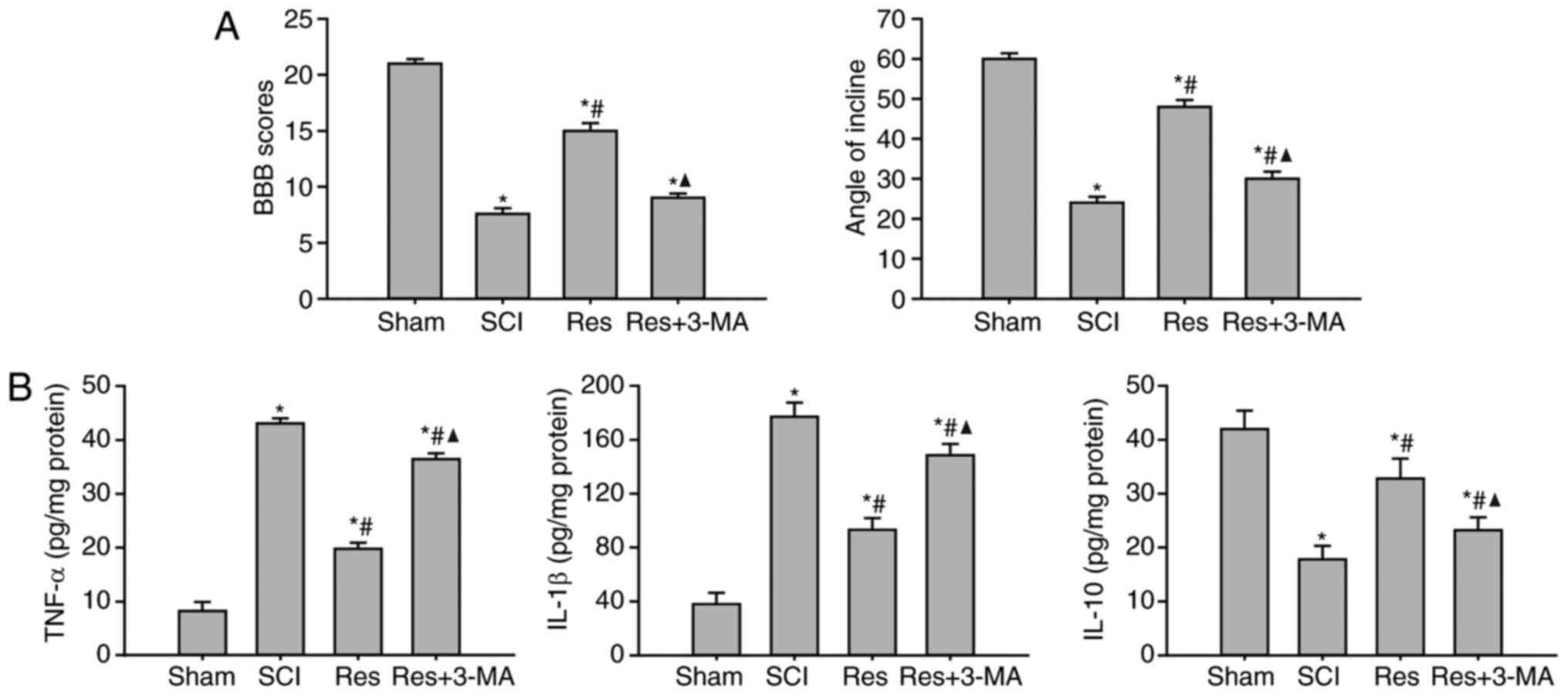 | Figure 6.3-MA treatment partially inhibits the
neuroprotective effects of resveratrol in SCI. (A) BBB scores and
inclined plane test scores for recovery of locomotor performance at
14 days post-injury. (B) Levels of TNF-α, IL-1β and IL-10 at 3 days
post-SCI, as determined using ELISA analysis. Data are presented
the mean ± standard deviation. *P<0.05, vs. sham group;
#P<0.05, vs. SCI group; ▲P<0.05, vs.
Res group. SCI, spinal cord injury; 3-MA, 3-methyladenine; Res,
resveratrol; TNF-α, tumor necrosis factor-α; IL, interleukin; BBB,
BBB, Basso, Beattie, Bresnahan. |
Resveratrol enhances autophagy via the
AMPK/mTOR pathway following SCI
To evaluate whether resveratrol induced autophagy
through the AMPK/mTOR signaling pathway, the present study examined
the effects of resveratrol on levels of AMPK, p-AMPK, mTOR and
p-mTOR. The expression of autophagy makers LC-3 and Beclin-1 peaked
at 3 days post-SCI, therefore the levels of AMPK, p-AMPK, mTOR and
p-mTOR were assessed at 3 days post-SCI. In addition, the recovery
of neurological function and axonal regeneration occurred at 21
days post-SCI, therefore, protein expression levels were determined
at 21 days post-SCI. An increased expression of p-AMPK and reduced
expression of p-mTOR were observed in the local injured spinal
cord, compared with levels in the sham group, which indicated that
the AMPK/mTOR pathway was involved in the activation of autophagy.
Resveratrol treatment significantly enhanced the level of p-AMPK
and decreased the level of p-mTOR following SCI at 3 and 21 days
(Fig. 7A and B, respectively).
Additionally, 3-MA treatment reversed the SCI-induced upregulation
of p-AMPK and downregulation of p-mTOR (Fig. 8). These results suggested that
resveratrol enhanced the SCI-induced activation of autophagy
through activating the AMPK/mTOR signaling pathway.
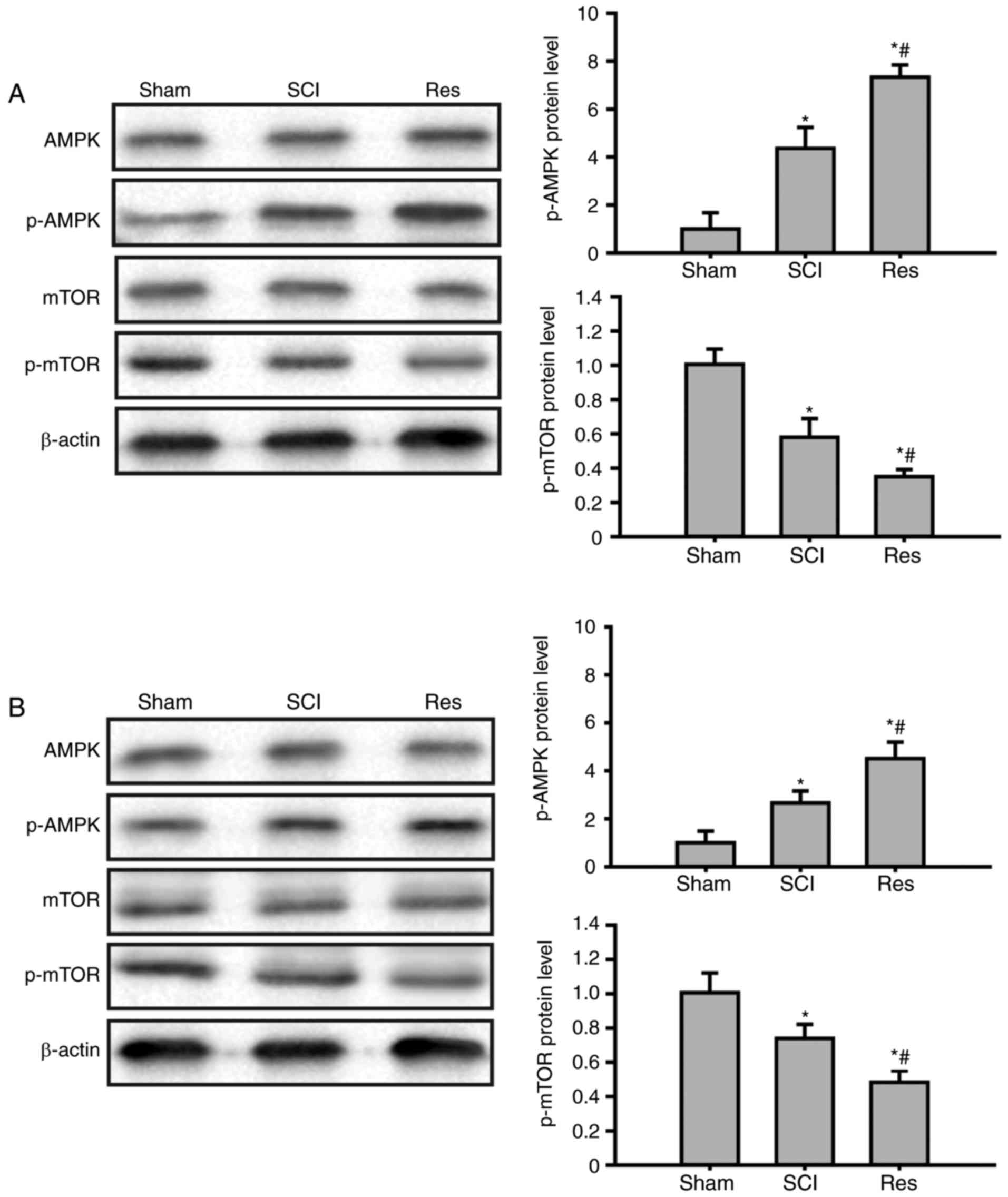 | Figure 7.Resveratrol activates autophagy via
the AMPK/mTOR signaling pathway. (A) Western blot bands and
quantitative analysis of protein levels of AMPK, p-AMPK, mTOR and
p-mTOR at 3 days post-SCI. (B) Western blot bands and quantitative
analysis of proteins levels of AMPK, p-AMPK, mTOR, and p-mTOR at 21
days post-SCI. β-actin was used as the loading control and for band
density normalization. Values are presented as the mean ± standard
deviation. *P<0.05, vs. sham group; #P<0.05, vs.
SCI group. SCI, spinal cord injury; Res, resveratrol; AMPK,
AMP-activated protein kinase; mTOR, mammalian target of rapamycin;
p-, phosphorylated. |
Discussion
SCI frequently leads to a permanent neurological
impairment as a result of primary injury followed by secondary
injury without effective treatment. Neuroinflammation and autophagy
are important in the progression of SCI. There is currently a focus
on identifying drugs that may improve neurological outcome, reduce
neuroinflammatory responses and promote neuronal survival following
SCI. Resveratrol, a natural phenolic compound, provides
neuroprotective effects in acute SCI, however, the specific
mechanisms of action have not been elucidated (13). In the present study, on verifying
the neuroprotective effects of resveratrol, it was found that
resveratrol significantly promoted the recovery of neurobehavioral
dysfunction and alleviated neuroinflammatory responses, finally
improving outcome post-SCI. Liu et al (14) demonstrated that resveratrol
improved neuron protection and neurological deficits following SCI
in vivo, consistent with the findings of the present study,
however, the exact mechanism of resveratrol-induced neuroprotection
remained unclear. Liu et al (15) also indicated that resveratrol
attenuated SCI-induced inflammatory damage in rat lungs. In the
present study, it was found that resveratrol suppressed SCI-induced
neuroinflammation in the injured spinal cord. The present study was
designed to investigate the effects of resveratrol treatment on
neurological outcome and neuroinflammation, but also to examine the
potential molecular mechanism underlying the neuroprotective
effects of resveratrol treatment following SCI in rats.
The activation of autophagy following SCI has been
widely observed in a series of studies (9,19).
Using a rat model of contusive SCI, Liu et al (20) observed the accumulation of
LC3-II-positive autophagosomes, appearing at 1 day post-injury.
Consistent with previous findings, the results of the present study
also showed that autophagy was activated in rats following SCI and
was sustained over a period of time, however, the role of autophagy
in the pathogenesis of SCI remains controversial. Several studies
have reported that the induction of autophagy protects neurons from
degradation and that the inhibition of autophagy contributes to
neurodegeneration (21). The
induction of autophagy may stabilize microtubules and promote axon
growth, and finally improve motor behavior recovery following SCI
(22). Evidence has also indicated
that transient spinal cord ischemia-induced autophagy in motor
neurons contributes to neuronal death and inhibits motor functional
recovery (18).
In determining whether autophagy is induced
following SCI as a neuroprotective mechanism, the present study
demonstrated that treatment with 3-MA, an autophagy inhibitor,
aggravated neurological impairments and neuroinflammatory responses
following SCI. However, whether the neuroprotective effects of
resveratrol are associated with the activation of autophagy has not
been reported. In the present study, the data demonstrated that the
SCI-induced activation of autophagy was enhanced by treatment with
resveratrol following surgery. In particular, in the SCI + Res +
3-MA group, it was found that 3-MA administration appeared to
partially inhibit the neuroprotective effects of resveratrol in the
SCI rats. These findings indicated that resveratrol treatment
promoted functional recovery and inhibited neuroinflammation
following SCI through enhancing the activation of autophagy.
The specific molecular mechanisms underlying the
enhancement of autophagy by resveratrol treatment was investigated
in more detail in the present study. A previous study indicated
that resveratrol exerts neuroprotective effects on SCI by
regulating autophagy and apoptosis mediated by the SIRT1/AMPK
signaling pathway (23). The
present study investigated whether the AMPK/mTOR pathway is
involved in resveratrol-mediated autophagy enhancement. The
AMPK/mTOR signaling pathway is primarily involved in regulating
autophagy. AMPK, a serine/threonine protein kinase, is not only a
major metabolic energy sensor, which regulates energy homeostasis
and metabolic stress, but is also important in autophagy and
protein degradation (24). mTOR, a
downstream target of AMPK and a negative regulator of autophagy, is
also important in the modulation of autophagy (25). It is reported that AMPK and mTOR
mediate autophagy by directly activating the phosphorylation of
Unc-51-like autophagy activating kinase 1 (26). In the present study, the levels of
AMPK, p-AMPK, mTOR and p-mTOR were detected 3 and 21 days post-SCI.
Rather than a focus on the dynamic alteration post-SCI, the effects
of resveratrol treatment on the AMPK/mTOR pathway were examined. It
was found that the expression of p-AMPK was significantly increased
and that of p-mTOR was markedly decreased in the injured spinal
cord tissues following SCI, which suggested that the SCI-induced
activation of autophagy was associated with the AMPK/mTOR signaling
pathway. Additionally, it was found that the administration of
resveratrol further enhanced the level of p-AMPK and reduced the
level of p-mTOR, indicating that resveratrol treatment enhanced
autophagy via activating the AMPK/mTOR pathway.
The findings of the present study showed that
resveratrol promoted functional recovery and attenuated the
neuroinflammatory response in rats following SCI. Therefore,
resveratrol treatment may be a potential therapeutic strategy for
SCI. The present study also confirmed that resveratrol may exert
these neuroprotective effects through the enhancement of autophagy
mediated by the AMPK/mTOR signaling pathway following SCI,
revealing a novel molecular basis for the neuroprotective role of
resveratrol.
Acknowledgements
The authors would like to thank Professor Niu from
the Hebei Medical University (Shijiazhuang, China) for critical
reading and revising of the manuscript.
Funding
No funding was received.
Availability of data and materials
The datasets and materials used and/or analyzed
during the current study are available from the corresponding
author on reasonable request.
Authors' contributions
HN and HM designed the experiments; DS, HL and XH
performed the experiments; GY and BX analyzed the data; HM wrote
and revised the paper; All authors read and approved the final
manuscript.
Ethics approval and consent to
participate
All protocols in the present study were approved by
the Ethics Committee of Hebei Medical University (Shijiazhuang,
China).
Patient consent for publication
Not applicable.
Competing interests
The authors declare that they have no competing
interests.
Glossary
Abbreviations
Abbreviations:
|
SCI
|
spinal cord injury
|
|
Res
|
resveratrol
|
|
BBB
|
Basso, Beattie, Bresnahan
|
|
LC3
|
microtubule-associated protein light
chain 3
|
|
3-MA
|
3-methyladenine
|
|
TNF-α
|
tumor necrosis factor-α
|
|
IL-1β
|
interleukin-1β
|
|
IL-10
|
interleukin-10
|
|
AMPK
|
AMP-activated protein kinase
|
|
mTOR
|
mammalian target of rapamycin
|
References
|
1
|
Saunders LL, Clarke A, Tate DG,
Forchheimer M and Krause JS: Lifetime prevalence of chronic health
conditions among persons with spinal cord injury. Arch Phys Med
Rehabil. 96:673–679. 2015. View Article : Google Scholar : PubMed/NCBI
|
|
2
|
Moon YJ, Lee JY, Oh MS, Pak YK, Park KS,
Oh TH and Yune TY: Inhibition of inflammation and oxidative stress
by Angelica dahuricae radix extract decreases apoptotic cell death
and improves functional recovery after spinal cord injury. J
Neurosci Res. 90:243–256. 2012. View Article : Google Scholar : PubMed/NCBI
|
|
3
|
Sekhon LH and Fehlings MG: Epidemiology,
demographics, and pathophysiology of acute spinal cord injury.
Spine (Phila Pa 1976). 26 24 Suppl:S2–S12. 2001. View Article : Google Scholar : PubMed/NCBI
|
|
4
|
Li HT, Zhao XZ, Zhang XR, Li G, Jia ZQ,
Sun P, Wang JQ, Fan ZK and Lv G: Exendin-4 enhances motor function
recovery via promotion of autophagy and inhibition of neuronal
apoptosis after spinal cord injury in rats. Mol Neurobiol.
53:4073–4082. 2016. View Article : Google Scholar : PubMed/NCBI
|
|
5
|
Shintani T and Klionsky DJ: Autophagy in
health and disease: A double-edged sword. Science. 306:990–995.
2004. View Article : Google Scholar : PubMed/NCBI
|
|
6
|
Angliker N and Rüegg MA: In vivo evidence
for mTORC2-mediated actin cytoskeleton rearrangement in neurons.
Bioarchitecture. 3:113–118. 2013. View Article : Google Scholar : PubMed/NCBI
|
|
7
|
Lipinski MM, Wu J, Faden AI and Sarkar C:
Function and mechanisms of autophagy in brain and spinal cord
trauma. Antioxid Redox Signal. 23:565–577. 2015. View Article : Google Scholar : PubMed/NCBI
|
|
8
|
Nikoletopoulou V, Papandreou ME and
Tavernarakis N: Autophagy in the physiology and pathology of the
central nervous system. Cell Death Differ. 22:398–407. 2015.
View Article : Google Scholar : PubMed/NCBI
|
|
9
|
Hao Y, Li L, Liu R, Shu B, Chen H, Huang
H, Hua R, Jiang F and An Y: Autophagy in long propriospinal neurons
is activated after spinal cord injury in adult rats. Neurosci Lett.
634:138–145. 2016. View Article : Google Scholar : PubMed/NCBI
|
|
10
|
Sun Y, Liu D, Su P, Lin F and Tang Q:
Changes in autophagy in rats after spinal cord injury and the
effect of hyperbaric oxygen on autophagy. Neurosci Lett.
618:139–145. 2016. View Article : Google Scholar : PubMed/NCBI
|
|
11
|
Baur JA, Pearson KJ, Price NL, Jamieson
HA, Lerin C, Kalra A, Prabhu VV, Allard JS, Lopez-Lluch G, Lewis K,
et al: Resveratrol improves health and survival of mice on a
high-calorie diet. Nature. 444:337–342. 2006. View Article : Google Scholar : PubMed/NCBI
|
|
12
|
Frémont L: Biological effects of
resveratrol. Life Sci. 66:663–673. 2000. View Article : Google Scholar : PubMed/NCBI
|
|
13
|
Lopez MS, Dempsey RJ and Vemuganti R:
Resveratrol neuroprotection in stroke and traumatic CNS injury.
Neurochem Int. 89:75–82. 2015. View Article : Google Scholar : PubMed/NCBI
|
|
14
|
Liu C, Shi Z, Fan L, Zhang C, Wang K and
Wang B: Resveratrol improves neuron protection and functional
recovery in rat model of spinal cord injury. Brain Res.
1374:100–109. 2011. View Article : Google Scholar : PubMed/NCBI
|
|
15
|
Liu J, Yi L, Xiang Z, Zhong J, Zhang H and
Sun T: Resveratrol attenuates spinal cord injury-induced
inflammatory damage in rat lungs. Int J Clin Exp Pathol.
8:1237–1246. 2015.PubMed/NCBI
|
|
16
|
Gao K, Wang YS, Yuan YJ, Wan ZH, Yao TC,
Li HH, Tang PF and Mei XF: Neuroprotective effect of rapamycin on
spinal cord injury via activation of the Wnt/β-catenin signaling
pathway. Neural Regen Res. 10:951–957. 2015. View Article : Google Scholar : PubMed/NCBI
|
|
17
|
Basso DM, Beattie MS and Bresnahan JC: A
sensitive and reliable locomotor rating scale for open field
testing in rats. J Neurotrauma. 12:1–21. 1995. View Article : Google Scholar : PubMed/NCBI
|
|
18
|
Zhou KL, Zhou YF, Wu K, Tian NF, Wu YS,
Wang YL, Chen DH, Zhou B, Wang XY, Xu HZ and Zhang XL: Stimulation
of autophagy promotes functional recovery in diabetic rats with
spinal cord injury. Sci Rep. 5:171302015. View Article : Google Scholar : PubMed/NCBI
|
|
19
|
Kanno H, Ozawa H, Sekiguchi A and Itoi E:
The role of autophagy in spinal cord injury. Autophagy. 5:390–392.
2009. View Article : Google Scholar : PubMed/NCBI
|
|
20
|
Liu S, Sarkar C, Dinizo M, Faden AI, Koh
EY, Lipinski MM and Wu J: Disrupted autophagy after spinal cord
injury is associated with ER stress and neuronal cell death. Cell
Death Dis. 6:e15822015. View Article : Google Scholar : PubMed/NCBI
|
|
21
|
Martinez-Vicente M and Cuervo AM:
Autophagy and neurodegeneration: When the cleaning crew goes on
strike. Lancet Neurol. 6:352–361. 2007. View Article : Google Scholar : PubMed/NCBI
|
|
22
|
He M, Ding Y, Chu C, Tang J, Xiao Q and
Luo ZG: Autophagy induction stabilizes microtubules and promotes
axon regeneration after spinal cord injury. Proc Natl Acad Sci USA.
113:11324–11329. 2016. View Article : Google Scholar : PubMed/NCBI
|
|
23
|
Zhao H, Chen S, Gao K, Zhou Z, Wang C,
Shen Z, Guo Y, Li Z, Wan Z, Liu C and Mei X: Resveratrol protects
against spinal cord injury by activating autophagy and inhibiting
apoptosis mediated by the SIRT1/AMPK signaling pathway.
Neuroscience. 348:241–251. 2017. View Article : Google Scholar : PubMed/NCBI
|
|
24
|
Hardie DG, Ross FA and Hawley SA: AMPK: A
nutrient and energy sensor that maintains energy homeostasis. Nat
Rev Mol Cell Biol. 13:251–262. 2012. View
Article : Google Scholar : PubMed/NCBI
|
|
25
|
Chang HJ, Ro SH, Jing C, Otto NM and Kim
DH: mTOR regulation of autophagy. FEBS Lett. 584:1287–1295. 2010.
View Article : Google Scholar : PubMed/NCBI
|
|
26
|
Kim J, Kundu M, Viollet B and Guan KL:
AMPK and mTOR regulate autophagy through direct phosphorylation of
Ulk1. Nat Cell Biol. 13:132–141. 2011. View
Article : Google Scholar : PubMed/NCBI
|

















